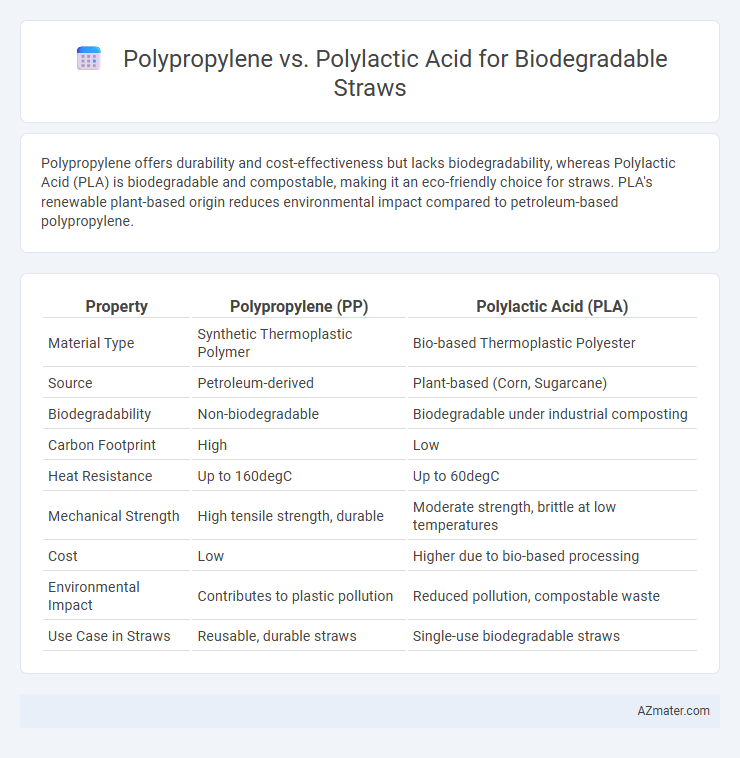Polypropylene offers durability and cost-effectiveness but lacks biodegradability, whereas Polylactic Acid (PLA) is biodegradable and compostable, making it an eco-friendly choice for straws. PLA's renewable plant-based origin reduces environmental impact compared to petroleum-based polypropylene.
Table of Comparison
| Property | Polypropylene (PP) | Polylactic Acid (PLA) |
|---|---|---|
| Material Type | Synthetic Thermoplastic Polymer | Bio-based Thermoplastic Polyester |
| Source | Petroleum-derived | Plant-based (Corn, Sugarcane) |
| Biodegradability | Non-biodegradable | Biodegradable under industrial composting |
| Carbon Footprint | High | Low |
| Heat Resistance | Up to 160degC | Up to 60degC |
| Mechanical Strength | High tensile strength, durable | Moderate strength, brittle at low temperatures |
| Cost | Low | Higher due to bio-based processing |
| Environmental Impact | Contributes to plastic pollution | Reduced pollution, compostable waste |
| Use Case in Straws | Reusable, durable straws | Single-use biodegradable straws |
Introduction to Biodegradable Straws
Polypropylene (PP) and Polylactic Acid (PLA) are two prominent materials used for biodegradable straws, each offering distinct environmental benefits. PP is a durable thermoplastic derived from fossil fuels but can be designed for partial biodegradability, while PLA is a bio-based polymer made from fermented plant starch, offering full compostability under industrial conditions. The choice between PP and PLA impacts the straw's degradation rate, environmental footprint, and suitability for various waste management systems.
What is Polypropylene (PP)?
Polypropylene (PP) is a thermoplastic polymer widely used in packaging, automotive parts, and consumer goods due to its high durability, chemical resistance, and low cost. In the context of biodegradable straws, PP is non-biodegradable and relies on mechanical recycling rather than natural decomposition. Its properties include high tensile strength and resistance to moisture, making it less environmentally friendly compared to polylactic acid (PLA), which is compostable and derived from renewable resources like corn starch.
What is Polylactic Acid (PLA)?
Polylactic Acid (PLA) is a biodegradable thermoplastic derived from renewable resources like corn starch or sugarcane, making it an eco-friendly alternative to traditional plastics. PLA is widely used in the production of biodegradable straws due to its compostability and low environmental impact, breaking down under industrial composting conditions within months. Unlike polypropylene, a petroleum-based plastic with long degradation times, PLA offers sustainable disposal options and reduces plastic pollution in marine and terrestrial environments.
Environmental Impact: PP vs PLA
Polypropylene (PP) straws are derived from fossil fuels and exhibit persistence in the environment due to their non-biodegradable nature, contributing significantly to plastic pollution and marine harm. Polylactic Acid (PLA) straws, made from renewable resources like corn starch, offer biodegradability under industrial composting conditions, reducing landfill accumulation and microplastic formation. Despite PLA's lower carbon footprint during production, its environmental benefits depend on appropriate composting infrastructure, highlighting the importance of waste management systems in mitigating overall ecological impact.
Biodegradability and Compostability Comparison
Polypropylene straws exhibit minimal biodegradability, persisting in the environment for hundreds of years due to their petroleum-based composition, whereas polylactic acid (PLA) straws are derived from renewable resources like corn starch and achieve complete biodegradation under industrial composting conditions within 1 to 3 months. PLA straws meet ASTM D6400 and EN 13432 standards for compostability, breaking down into water, carbon dioxide, and biomass without leaving toxic residues, unlike polypropylene which lacks certified compostability. The superior compostability and faster degradation rate of PLA make it a more environmentally sustainable option compared to the long-lasting plastic pollution risk posed by polypropylene straws.
Material Properties and Performance
Polypropylene (PP) offers high tensile strength, excellent flexibility, and chemical resistance, making it durable for reusable straws but non-biodegradable. Polylactic Acid (PLA), derived from renewable resources like corn starch, provides biodegradability and compostability but has lower heat resistance and mechanical strength compared to PP. PLA straws degrade under industrial composting conditions within months, while PP straws persist in the environment for hundreds of years, impacting sustainability goals.
Cost Analysis: PP Versus PLA Straws
Polypropylene (PP) straws generally cost less to produce than polylactic acid (PLA) straws due to cheaper raw materials and established manufacturing processes. PLA straws incur higher expenses because of their bio-based sourcing and limited production scale, resulting in a price premium of approximately 20-40% compared to PP. Cost differences influence the adoption rate in the biodegradable straw market where budget constraints often favor PP despite environmental concerns.
Safety and Food Contact Regulations
Polypropylene (PP) is widely recognized for its chemical stability and compliance with FDA and EU food contact regulations, ensuring safe use in biodegradable straws without leaching harmful substances. Polylactic acid (PLA), derived from renewable resources, is biodegradable and meets food contact safety standards but may have lower heat resistance and potential migration risks under high temperatures. Selection between PP and PLA for biodegradable straws depends on balancing regulatory compliance, application temperature, and environmental impact considerations.
Consumer Perception and Market Trends
Consumer perception of polypropylene straws remains mixed due to environmental concerns, while polylactic acid (PLA) straws are increasingly favored for their compostability and renewable bio-based origin. Market trends indicate a rising demand for PLA straws driven by regulatory bans on single-use plastics and growing eco-consciousness among millennials and Gen Z consumers. PLA straws are projected to capture significant market share in biodegradable straw segments, reflecting a shift toward sustainable alternatives in the foodservice industry.
Conclusion: Choosing the Right Biodegradable Straw
Polypropylene offers durability and cost-effectiveness but lacks rapid biodegradability, making it less ideal for sustainable straw options compared to polylactic acid (PLA). PLA stands out with its compostable properties and lower environmental impact, fitting eco-friendly initiatives and reducing plastic pollution significantly. Selecting the right biodegradable straw depends on prioritizing either longevity and strength or environmental sustainability and compostability.

Infographic: Polypropylene vs Polylactic Acid for Biodegradable Straw
 azmater.com
azmater.com